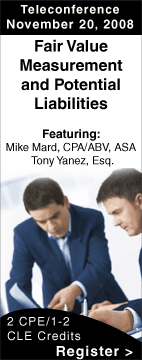
| Is there an IRS review in your future? The latest entry from a newcomer to the blogging scene, BVMaven, warns that the IRS will start reviewing Section 409a appraisals on January 1, 2009—and will even “review appraisals going back to when the provision was implemented in 2005.” The BVMaven confirmed this conventional wisdom in a recent conversation with an IRS representative. The conclusion: “As it stands now, we should all be afraid, very afraid,” the Maven concludes, especially in light of the government’s extremely limited guidance on Section 409a compliance, the possible confusion caused by FAS 123R appraisals and the beefing up of the IRS penalty review process. But it’s not all bad news. The conversation did yield some meaningful editorial comments from the IRS rep. “Basically, when pressed for best practices, the rep emphasized that the review pile will be somewhat divided into those reports which adhere to one or more of the professional standards (USPAP, AICPA, NACVA, etc.) and those that do not.” The latter pile will receive greater scrutiny. “Further, the IRS is leveraging the learning process of the financial reporting community, and as a result will likely embrace things like the equity allocation methods (i.e. OPM or PWERM). If you do these kinds of valuations, you know that’s huge. You also know that means every valuation under current value could be open season.” As for the BVMaven’s take on the difficulties of doing FAS 142 impairment evaluations, in the current “doom and gloom” economy, see the blog dated October 11, 2008, and entitled, “How About I Impair Your Face?” Appraisers to Feds: don’t weaken FAS 157 The American Society of Appraisers (ASA), the Royal Institution of Chartered Surveyors (RICS) and the American Society of Farm Managers and Rural Appraisers (ASFMRA) have written to the Securities and Exchange Commission (SEC) and other federal agencies to raise their joint concerns over changes to the FAS 157 rule. While supportive of the SEC and FASB's effort to provide clarification on the issue of valuing financial assets, ASA, RICS and ASFMRA believe that a suspension of FAS 157, temporary or otherwise, for illiquid assets, is not beneficial.
The group asserts that—given the current crisis in the financial markets, subprime mortgage issues and general worldwide economic instability—fair valuation standards are necessary to generate future global investor confidence. Their contention: Such standards create a financial reporting system based on transparency, proper disclosure and mark to market information which, in turn, provides true valuation data to investor, regulator, policymaker and taxpayer. “The current economic crisis is driving emergency actions including the easing of fair value requirements for reporting securities. However, it is important that regulators and the market do not lose sight of the basis for fair value reporting of financial instruments and all other assets,” explains Ronald Seaman, a Fellow of the American Society of Appraisers and the organization's International President. For expert opinions on all the latest relating to FAS 157, sign up for FASB Update: Potential Liabilities and Volatility, a very special BVR teleconference on November 20th with Mike Mard of The Financial Valuation Group and Tony Yanez of Willkie Farr & Gallagher, LLP. You can view the complete agenda and register here. Juries may take ‘a few years’ to trust lending (and appraisal) practices In 2000, a steel plant in the U.K. sought an asset-based loan from Bank of America. The bank recommended a local appraisal firm, which reported a range of value between $7.0 million (forced liquidation) and $8.5 million (orderly liquidation). The bank agreed to lend the plant $5.75 million, and then turned around and sold the loan in a $374 million portfolio to Wells Fargo. At the time, Wells Fargo engaged the same appraisal firm to conduct a second valuation—but later refused to pay for it, perhaps because the steel plant’s forced liquidation value came back at only $2.86 million. By March 2002, the steel plant was in receivership, its assets selling for only $2.2 million. But when Wells Fargo tried to sue the appraisal firm for breach of contract, the U.S. District Court (Illinois) found that it was not a beneficiary of the contract between the appraisers and the steel plant. “The only beneficiary was the borrower.” Plus, the court was none-too impressed with the bank’s due diligence. The one Wells Fargo employee who reviewed the steel plant loan couldn’t remember the loan, the appraisal—or the portfolio, and his handwritten note referenced an incorrect value for the appraisal. “[I]t is difficult to reconcile the error….with the claimed practice of careful examination of the appraisal,” the court said, in dismissing the claims. Although the bank could file an alternative suit, based on negligent misrepresentation, it would have to show a “rigorous processing of its loan portfolio.” That could be difficult for any lender to prove, the court warned, in what could be an ominous footnote for the U.S. banking industry. “It will be a few years before an American jury [will] be likely to accept the premise of careful lending.” We’ll include the complete case abstract for Wells Fargo Business Credit, Inc. v. Dovebid Valuation Services, Inc. (Sept. 18, 2008) in the upcoming December issue of Business Valuation Update™. Three ways to create a “buzz” for your BV practice What can the “big boys” teach small firm BV experts about selling their services to prospects. Plenty, we believe, so consider the suggestions offered by an insider with Willamette Management Associates. Hale Chan, the firm’s marketing communications director, says that Willamette encourages their senior people to reach out to current and past clients, identify their business valuation needs and then offer solutions to meet those needs. Chan, who recently spoke to a group of legal and business executives on how to generate media attention, said that BV experts appear to be incorporating more and more media relations into their marketing plans. “Being part of a news story not only gives you tremendous exposure but a lot of instant creditability.” Chan offers his three top tips for generating media attention: 1) Develop relationships with the media BEFORE you need them. 2) Make sure your pitches or press releases are relevant, timely, and newsworthy to their specific readers. 3) Don’t be a pest. Key is to target the right reporter for your pitches. Don’t bother them to find out if they received your news release or if they plan to run with your story idea. If they are interested, they will get back to you. What's the impact of compensation when valuing a medical practice? In valuing medical practices using the excess earnings method, the most important adjustment is the one for reasonable compensation, explains Mark Dietrich, who along with Cindy Eddins Collier, served as editor of our new BVR's Guide to Healthcare Valuations. “Determining the reasonable compensation for a physician requires more than merely looking at a statistical source and choosing the mean or median. The valuation analyst needs to first compare the physician’s productivity or work effort to statistical norms and then base the reasonable compensation on that productivity,” he writes. Dietrich, who also served as technical editor for the Guide, notes that the following are additional considerations that must be taken into account:
Want to know more? We’ve included an excerpt from our much anticipated BVR's Guide to Healthcare Valuations (which is set to ship in about two weeks) in our November issue of Business Valuation Update™. A free guide to valuing mining companies Ian Campbell of Toronto’s Campbell Valuation Partners is quickly progressing through his 17 post series on the valuation of mining companies; Campbell’s insights were culled from his recently updated E-book. The initial posts contain an introduction and an index of what’s to come. Subsequent posts include an overview of the industry, risk assessment, and valuation methods that include asset based, earnings and cash flow based, comparables based and other valuation methodologies. Ian is a Fellow of the Institute of Chartered Accountants of Canada and a founding member and Fellow of the Canadian Institute of Chartered Business Valuators.
|
||
To ensure this email is delivered to your inbox,
please add editor@bvwire.com to your e-mail address book.
We respect your online time and privacy and pledge not to abuse this medium. To unsubscribe to BVWire™ reply to this e-mail with 'REMOVE BVWire' in the subject line or click here.
Copyright © 2008 by Business Valuation Resources, LLC
BVWire™ (ISSN 1933-9364) is published weekly by Business Valuation Resources, LLC
Editorial Staff | Advertise in the BVWire | Copyright Notice
|
|



